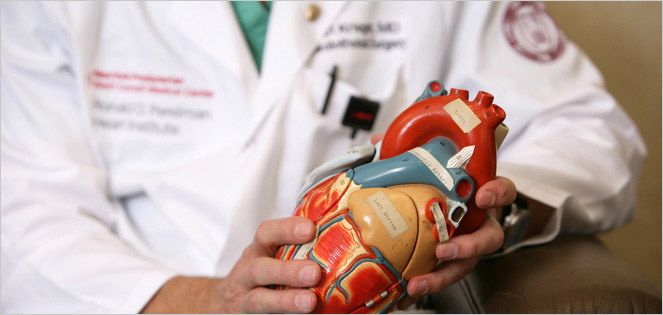
With heart failure, the heart becomes too weak to efficiently pump blood to other parts of the body. Some patients benefit from drug therapy. But others may require a heart transplant or other intervention. When heart failure reaches this advanced stage, it can be life-threatening. Weill Cornell Medicine|NewYork-Presbyterian offers exceptional care to help these patients live longer and enjoy a better quality of life.
Since there are not enough donor hearts to meet the needs of all the patients who require them, patients with end-stage heart failure may benefit from mechanical cardiac assist devices, the most common of which are ventricular assist devices (VADs). VADs can be used in patients as temporary support while waiting for heart muscle recovery, as temporary support while awaiting a heart transplant ("bridge to heart transplant"), and as "destination" (permanent) therapy for those who are not eligible for a transplant.
The left ventricle is the chamber responsible for pumping oxygen-rich blood from the heart to the aorta for transport to the rest of the body. Left ventricular assist devices (LVADs) take on the workload of the left ventricle, helping the heart to pump oxygenated blood to the rest of the body. As a result, all tissues and organs receive the blood supply they need to do their jobs. The patient feels better and can return home to live a better quality of life with family and friends.
In addition, some patients require support of the right heart as well, which pumps blood to the lungs, where it can receive oxygen. Right ventricular assist devices (RVADs) are commonly used in conjunction with LVADs, and are referred to as biventricular assist devices (or BiVADs).
Our surgeons specialize in the implantation of a wide variety of VADs, selected and tailored for each individual patient and their particular situation. A multidisciplinary team — comprised of surgeons, cardiologists, nurses, physical therapists, psychiatrists, nutritionists, and social workers — assures that patients receive comprehensive care, both in the hospital and once they are discharged home.
The VAD consists of:
- A pump: The pump is implanted in or near the upper part of the abdominal wall and is connected to the heart at two points. A tube carries blood from the ventricle to the pump. The blood is pumped through a second tube to the aorta or pulmonary artery, and distributed to the lungs or throughout the body.
- An electronic control system: A third tube extends from the pump and contains wires that connect the pump to the electronic control system.
- A power supply (rechargeable batteries): The control system is connected to small batteries. Patients wear the controller on a belt and the batteries on a vest-like shoulder holster.




